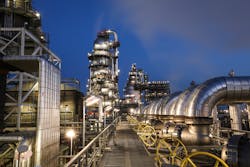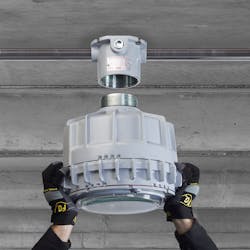Luminaires play a critical role in the safe, efficient, and productive operation of any industrial facility or production process. Darkened, enclosed, and round-the-clock operations rely on them exclusively for illumination. Daylight operations benefit from the additional and spot lighting they provide. However, facilities, such as petrochemical, refining, and grain storage, require more from their lighting. In addition to providing illumination, luminaires for these industries must address and overcome the inherent challenges of hazardous environments.
Hazardous environment luminaires are designed to specifically handle the highly corrosive elements, combustible dusts, and flammable gases/vapors that are endemic to these industries. This article examines the distinct hazardous environments defined by global electrical codes, which luminaires are suited for them, and the technologies that are available to help keep them operating longer and safer. This information provides the foundation for achieving optimal plant safety and efficiency through proper lighting, safe electrical installation, and operation.
Around the world, hazardous locations are broken down into different categories, each of which defines the type of hazard present, its explosive force, and if its exposure is part of normal or abnormal facility operations.
Class of threats
The National Electrical Code (NEC) and earlier editions of the Canadian Electrical Code (CEC) divide hazardous environment combustible dusts and flammable gases and vapors into three separate Classes:
- Class I locations are categorized by the flammable gases and vapors present in industries, such as natural gas, petroleum, and chemical.
- Class II locations contain combustible dusts that can be carried aloft during pulverizing processes or compacted in storage centers. Combustible dusts are found inside plastic, pharmaceutical, coal, and agricultural (grain and flour) processing locations.
- Class III locations contain the ignitable fibers and flyings that are produced in the wood, cotton, and textile industries, among others.
Define the presence with divisions
NEC/CEC Divisions define hazardous environments by the amount of exposure to the gases, vapors, or dusts. Division 1 classifies hazardous atmospheres in which the flammable gas, vapor, or combustible dust is present during normal operations or routine maintenance. The existing or potentially hazardous atmosphere must also be in the right mixture concentrations to be ignitable. Thus, proper ventilation can change a Division 1 location in to a Division 2 location.
Division 2 locations are where hazards are encountered only during an abnormal situation, such as equipment failure or a spill. Locations adjacent to Class I, Division 1 areas may also be deemed Division 2 in order to accommodate for the potential seeping of gases or vapors.
Groups within each class
Class ratings are further broken down into material groups, which identify the explosive characteristics of the material. The volatility of these groupings is based on maximum experimental safe gap (MESG) and minimum ignition current (MIC).
Class I locations consist of Groups A, B, C, and D:
- Group A, acetylene, features the highest outward pressure during an explosion.
- Group B is hydrogen.
- Group C is ethylene.
- Group D is gasoline.
Class II locations are divided into three Groups: E, F, and G in accordance with NFPA 499.
- Group E is combustible metal dust, such as aluminum and magnesium.
- Group F consists of coal, printer ink powder, and coke.
- Group G features agricultural dusts, such as cake mix, grain dust, and flour.
Class III locations are not broken down into groups.
Around the globe
The International Electrotechnical Commission (IEC) and European Committee for Electrotechnical Standardization (CENELEC) classify hazardous locations into Zones, Groups, and Gas Groups. The CEC and NEC include provisions for the Zone system in addition to the Division classification scheme. Zones are similar to the NEC/CEC Divisions, except that they classify three levels of the existence of hazardous atmospheres instead of two.
- Zone 0: Hazardous atmospheres are continuously present.
- Zone 1: Hazardous atmosphere is often present.
- Zone 2: Hazardous atmosphere may accidentally be present.
Equipment Groups are used to denote equipment used for the mining industry. Group I consists solely of mines. Group II encompasses every industry but mining. The Atmosphere Groups of A, B, and C rate the pressure caused by an ignited gas, vapor, or dust, much like the NEC/CEC Group. However, they are placed in the opposite order. Therefore, Gas Group C represents the extreme force of hydrogen and acetylene while Gas Group A denotes the less destructive forces of gasoline and natural gas.
Safely lighting facilities for the different Classes, Groups, and Divisions requires engineering and manufacturing a variety of luminaire designs. Each design incorporates features that meet the specific rating criteria of the hazardous location.
Explosionproof luminaires for Class I, Division 1
Due to the ever-present condition of hazardous gases or vapors, luminaires placed in Class I, Division 1 locations must ensure that ignition is never allowed into the environment.
To achieve this, engineers calculate that the gas or vapor has successfully leaked into the interior of the luminaire and has ignited. To prevent ignited gases or vapors from propagating to the surrounding atmosphere, explosionproof luminaires feature engineered flamepaths, which prevent burned gases from an explosion to the surrounding atmosphere only after the gas has traveled within the luminaire’s flamepaths long enough to cool. Cooled gases are released from the flamepaths at temperatures that will not ignite the surrounding flammable atmospheres. Depending on the luminaire’s design and application, these flamepaths can be incorporated into ground joints, threaded joints, labyrinth-paths, close tolerance shafts, interlocking concentric rings, and precision acme/conical threads.
Encapsulated and flameproof luminaires for Zone 1 applications
Two common ATEX/IECEx Protection Concepts for Zone 1 environments include Flameproof (d) and Encapsulation (ma and mb). Flameproof construction contains and vents the explosion using engineered flamepaths similar to explosionproof construction. Encapsulation construction keeps the flammable substances out by sealing LED arrays and drivers using common potting polymer systems, such as epoxies, silicones, and polyurethanes. The characteristics of LED light sources and supporting electronic components are particularly well suited to the application of encapsulation to isolate both electrical connections and heat sources from the intrusion of gases.
Enclosed & gasketed luminaires for Class I, Division 2 & Class II/Zone 2, 20, 21, and 22
Class I, Division 2/Zone 2 luminaires must be gasketed to prevent the hazardous atmosphere from entering the luminaire’s interior. As such, enclosed and gasketed luminaires are most suitable for this environment. Class II/Zone 20, 21, and 22 luminaires also must function under a blanket of explosive dust as grain silos and other agricultural and mineral processing plants position lights where they can become covered by dust or grains for extended periods of time. These conditions mandate that enclosed and gasketed luminaires prevent dust ingress and keep temperatures low. Internal control components need to be engineered to radiate less heat. Surfaces need to be contoured to prevent the accumulation of dust on the luminaire and reduce blanketing. If not engineered properly, exterior light temperatures can soar.
Temperatures to a “T”
Every hazardous atmosphere has a temperature that, if exceeded, will cause the flammable or combustible to ignite. Accordingly, this temperature, called the “T” rating, is a critical safety benchmark. Hazardous location luminaires must run cooler than the ignition temperature of the surrounding atmosphere. Per the “T” rating chart (see Table below), T1 rated luminaires can only be used in locations where the atmosphere needs a temperature greater than 450°C to ignite. Conversely, T6 rated luminaires run the coolest and can be used in very volatile environments where temperatures cannot exceed 85°C.
The “T” rating for a luminaire is the temperature of the hottest spot on or in the luminaire, depending on the luminaires’ Class or Zone rating. Whether the “T” rating is recorded on or in the luminaire depends on whether it is an explosionproof, flameproof, encapsulated, or enclosed and gasketed. For explosionproof, flameproof, and encapsulated luminaires, the “T” ratings are measured on the exterior of the luminaire. This is due to the explosionproof, flameproof, or encapsulated luminaire’s ability to disarm any explosion caused within the interior of the luminaire. Therefore, the exterior temperature of the luminaire becomes the foremost concern. Class II, Division 1 T-codes are also measured on the exterior of the luminaire. Enclosed & gasketed luminaires measure their “T” ratings on the inside. If a hazard is accidentally released into the atmosphere and reaches inside the luminaire, it will not ignite, assuming the luminaire’s “T” rating is below that of the hazard.
Keeping your cool in hazardous atmospheres
A luminaire that lasts longer is safer for the production line and the maintenance crew. It provides more light over its lifetime and reduces the potential of a maintenance-related accident by stretching out the amount of time between servicing. Simply put, cooler running luminaires stay lit longer. That’s why it is important to design and manufacture enclosed and gasketed, explosionproof luminaires that reduce the amount of heat they produce.
Thermal design
When it comes to LED luminaires, reliability begins with good thermal design. Product designs need to take into consideration such facets as placement of LED drivers and LED array boards, and the thermal design needed to draw heat away from the internal components and direct it out through the casting. Reliable LED luminaire designs emphasize thermal performance first and foremost to provide long-term field reliability. Extensive thermal simulation during the design process ensures driver electronics and LED semiconductor devices operate within their thermal limits even at the fixture’s maximum rated ambient temperature. Choose luminaires that deliver rated illumination through their full ambient operating temperature range to make sure your facility is safely lit even when the going gets hot.
Complex engineering made simple
The seemingly simple look of hazardous location lighting can often cause work crews to underestimate the environments that they work in and the engineering of these luminaires. This is reinforced by surveys that show maintenance practices usually do not follow standard guidelines. For example, 80% of the time, HID luminaires are relamped with the electrical power on. In the 20% of the time that the power is turned off, 69% of the relamping happens as soon as the power is shut off. This does not allow the proper amount of time for many luminaires to cool. Utilizing LED technology eliminates these safety hazards posed by improper relamping procedures. However, research also shows that 32% of gaskets and seals are not inspected, and maintenance crews are “pretty sure” the gaskets are properly sealed only 55% of the time, according to the IEEE.
Again, LED luminaires eliminate these risks by removing the need for maintenance altogether. New risks, however, have arisen with the use of LED retrofit lamps. Care must be taken to ensure that any retrofit lamp used in a hazardous location has been tested and certified for use in that fixture. New labels must be provided to identify a retrofitted luminaire complete with correct wattage and T-code information. Retrofit lamps that require disconnecting the existing ballast violate warranty and pose additional concerns.
Reliable protection
Careful gasket design is essential to keeping water and dust on the outside. Critical to the reliability, gasket seals must be tested to the stringent application requirements encountered in heavy industrial and hazardous applications. ISO accredited third-party laboratories conduct gasket performance testing according to ASTM-D-395.
Since lighting in hazardous locations is both a necessity and a potential danger, knowing the facility environment, combustible composition, and luminaire application enables the proper lighting design for a safe and productive working environment.
Helm is director of product development of Emerson Automation Solutions, Rosemont, Ill. She has nearly two decades of experience in electrical and lighting technology and holds a BSEE from Valparaiso University and an MBA from the University of Colorado. She can be reached at [email protected].
About the Author
Ellen Helm
Helm is director of Emerson Automation Solutions, Rosemont, Ill. She has nearly two decades of experience in electrical and lighting technology, and holds a BSEE from Valparaiso University and an MBA from the University of Colorado. She can be reached at [email protected].






